Ants in Trace State Park, Pontotoc County, Mississippi, 18 May 2006 [MS State Park Ants]
Joe A. MacGown and JoVonn G. Hill
Trace State Park is located in Belden, Pontotoc County, Mississippi. It is ten miles east of Pontotoc and nine miles west of Tupelo off of Highway 6. The park is on 2500 acres and has a large 600 acre lake. Over 25 miles of trails wind through some very nice forested areas. Much of the area is very hilly with some steep ravines present.
With John Barone, a plant ecologist from Columbus State University, along with us, we arrived at the park at about 1:00 P.M. We stopped by the front office area and informed the girl working there that we there to collect ants. She said she could point out a few nice sized fire ant mounds that we were welcome to take with us. Of course, we thanked her, but declined, and headed into the park to see what ants we could find. We drove around a bit to get the lay of the land and decided to start our collections from "Bushwacker camp and trail" at 34°15'41"N 88°53'55"W. To get to this area we turned right from the entrance and kept going straight, rather than turning left toward the cabin and lake area. The paved road eventually ran into a dirt road, which we followed until it turned to the left. The bushwacker camp was at the top of the hill to the right of the road where it started curving to the left. There was a small pavilion there with picnic tables and several trails that branched out into the woods. The woods were mostly deciduous with many large oaks and hickories present. The area was dissected with fairly steep ravines and ridges. The soil was very sandy, especially on the ridge tops and there was plenty of leaf litter on the forest floor. Temperatures were not outlandish for this time of year, being only in the mid 80's and we were quite comfortable. Before we began our collections, we sat down at the picnic tables to eat our fine feast we had purchased from a relatively nearby Sonic restaurant.
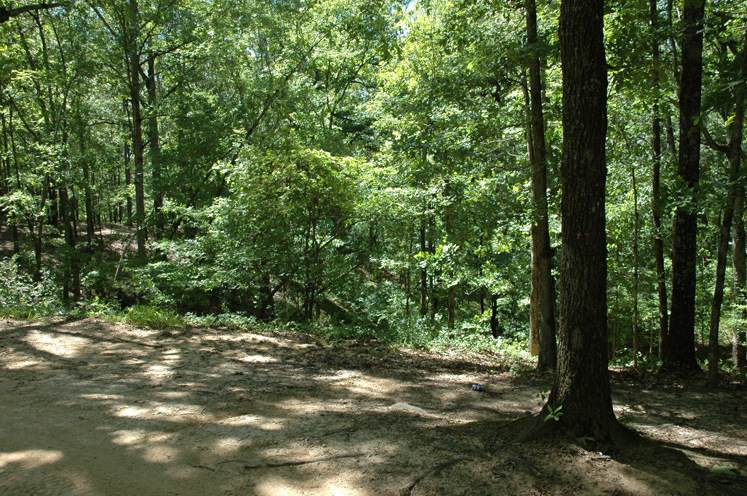
The woods near Bushwacker Camp
After we ate our lunch, we got to work collecting ants, while John traveled the trails and took photographs. One of the first things we did was plaster some peanut butter on some oaks about chest high. Periodically, we checked this bait and collected Aphaenogaster lamellidens Mayr, Crematogaster ashmeadi Mayr, Pheidole dentata Mayr and Temnothorax schaumii Roger there. Both the Aphaenogaster and the Crematogaster are very common species in wooded habitats, but T. schaumii is seldom seen because of its cryptic habits. Fortunately, they seem to love peanut butter, and are easily collected by this method.
As we wandered about we saw plenty of Trachymyrmex septentrionalis (McCook) colonies. We typically find loads of these fungus growing ants in similar habitats with sloped forests and sandy soils, so this was not surprising. We also found several colonies of the imported hybrid fire ant, Solenopsis invicta X richteri, which was seen in large numbers throughout the park. Colonies of both Formica dolosa Buren and Formica pallidefulva Latreille were nesting in the soil. We searched through some of these colonies in hopes of finding either some interesting myrmecophiles or the slave making ant Polyergus, but had no luck. We also found colonies of Camponotus chromaiodes Bolton, Aphaenogaster carolinensis (Wheeler), Aphaenogaster treatae Forel, Pheidole dentigula Smith, and Crematogaster lineolata (Say) in soil and leaf litter. These are all fairly common open woodland species. Aphaenogaster lamellidens Mayr and Pheidole dentata Mayr were found nesting in rotting wood. The Aphaenogaster was very common there and many colonies were found. Individuals of Prenolepis imparis (Say), Camponotus americanus Mayr, and Camponotus snellingi Bolton were seen running on the forest floor, although no nests were found. Searching litter at bases of trees yielded some of the above mentioned species as well as Ponera pennsylvanica Buckley, Monomorium minimum (Buckley), Solenopsis carolinensis, and Temnothorax curvispinosus Mayr.
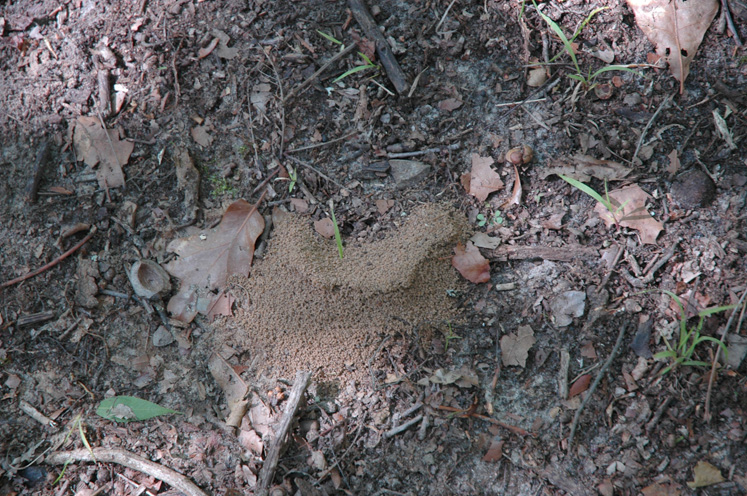
The crescent shaped mound above the entrance to a Trachymyrmex colony.
In addition to our hand collecting, we collected 3 gallon sized and 2 larger bags of litter, which we took back to the lab to extract the insects from in Berlese funnels. The leaf litter was collected from bases of deciduous trees and from beside rotting logs on the ground. Many of the species collected by hand were also in the resulting Berlese samples, but some additional species were in there as well including Lasius americanus Emery, Strumigenys angulata Smith , Strumigenys ohioensis Kennedy & Schramm, Strumigenys ornata Mayr, and Strumigenys louisianae Roger. With the exception of L. alienus, all of the additions were minute dacetine ants, which are highly specialized predators that dwell in soil and leaf litter. Litter sampling is the most effective way to collect these tiny, cryptic ants because they are small, slow moving, and with their brownish coloration they blend in with the soil and leaf litter.
After collecting near Bushwacker camp for about an hour and 45 minutes, we decided it was time for a change. We drove over toward the cabins near the lake, but there were some people there, so we drove over to the other side of the lake and explored the primitive campsite (34°15'21"N 88° 53'23"W). This site was different than many primitive sites that we have seen in that it was very open with scattered loblolly pines and oaks. The soil was very sandy and the entire area bordered the lake. We didn't spend long there, but long enough to see many colonies of Forelius mccooki (McCook), Monomorium minimum, and the hybrid fire ant (Solenopsis invicta X richteri), which were all nesting in the soil. Forelius mccooki nests in open areas and we specifically stopped here to pick this species up, hoping it would be there.
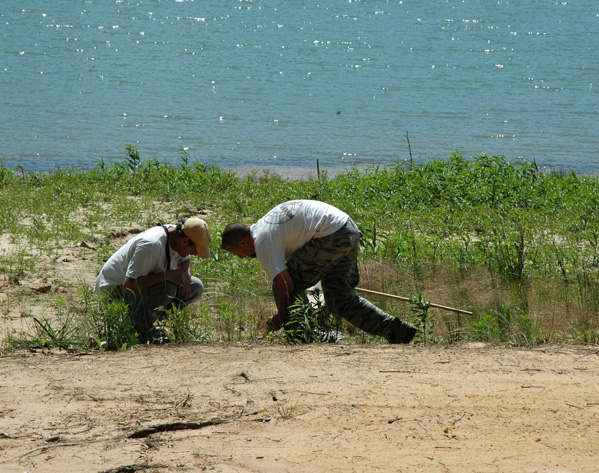
JoVonn and John looking at bugs by the lake shore
After leaving the primitive campground we drove around until we came to a disc golf course area that ran along a nice hiking trail through a mixed pine-oak forest (34°15'24"N 88°53'12"W). To get to this area we had to walk up a big hill that had been planted with wildflowers. Off to the left before getting to the trail was an area with many cedar trees that had some semi open prairie areas interspersed. Several ant species were collected in these prairie remnants including Forelius mccooki, Brachymyrmex depilis Emery, Paratrechina vividula (Nylander), Formica dolosa, Ponera pennsylvanica, Monomorium minimum, Solenopsis invicta X richteri, Pheidole dentata, and P. tysoni Forel. All of these species are common ants in open habitats and were not unexpected.
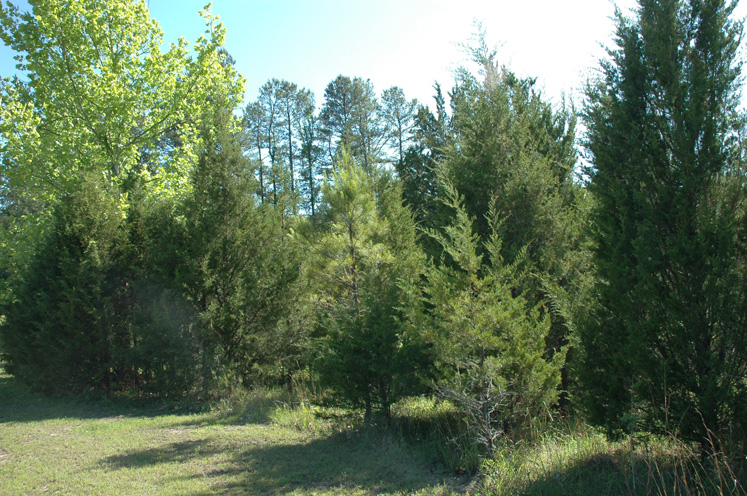
A prairie remnant nar the entrance to the disc gulf area course.
The trail through the mixed forest proved to be ideal habitat for several species and we found many colonies of Camponotus chromaiodes, Formica pallidefulva, Trachymyrmex septentrionalis, and Crematogaster lineolata in the soil and Aphaenogaster lamellidens in rotting wood. Aphaenogaster carolinensis (Wheeler) was also found nesting in the soil. Colonies of Crematogaster pilosa Emery were found in rotting sticks on the ground. Other ants seen and collected running around were Paratrechina faisonensis (Forel), Prenolepis imparis, Camponotus americanus, C. snellingi, and Crematogaster ashmeadi. Before leaving this area we collected six bags of litter. In addition to some species we collected by hand there were several other species in the litter samples including Lasius alienus, Hypoponera opacior (Forel), Ponera pennsylvanica, Strumigenys angulata Smith , Strumigenys clypeata , Strumigenys ohioensis, Strumigenys ornata , Strumigenys louisianae, Pheidole dentigula Smith, Temnothorax curvispinosus, Temnothorax pergandei Emery, and Myrmecina americana Emery. At 4:20 P.M. we called it quits and headed to a small prairie remnant near Tupelo to collect before finally going back to Starkville.
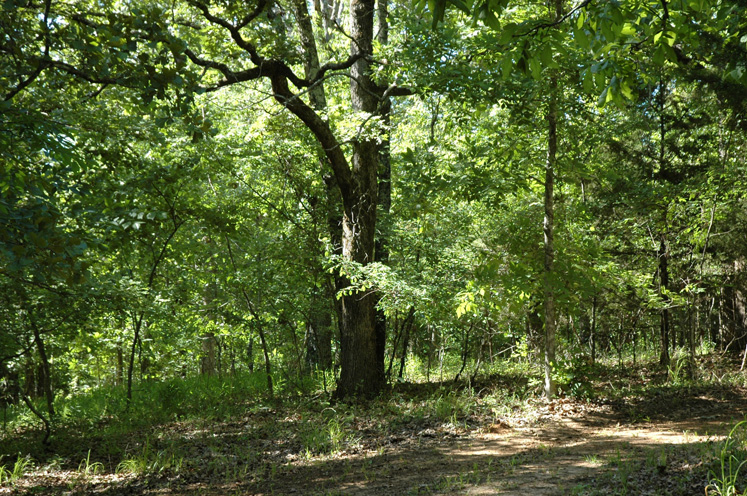
The forested area on the disc golf course.
A return trip was made to the park on May 5, 2010 by MacGown, Hill, and James G. Lewis. We collected at the campground site at 34°15'03"N 88°53'38"W and on the nature trail at 34°15'15"N 88°54'02"W. The campground, which was basically an open mixed wooded, park-like area near a lake, was targeted for possible exotic species. Exotic species are sometimes transported by RV's, and these campgrounds are likely destinations for these species. However, in this case, the only exotic species we collected was the hybrid form of the red and black imported fire ants, Solenopsis invicta x richteri, which was known to be well established in the region and was collected at the park previously. Other common species at the site included Camponotus castaneus, C. chromaiodes, Crematagaster missiuriensis (new for the park), Forelius mccooki, Monomorium minimum, Pheidole bicarinata, and P. tysoni. After collecting at the campground, we collected along thenature trail, which was in mixed pine/hardwood habitat. Numerous colonies of Trachymrymex septentrionalis were seen along the somewhat sandy, hilly trail. Foraging workers of Formica pallidefulva were observed throughout the habitat. Colonies of Aphaenogaster carolinensis and Camponotus castaneus were found in the soil, and Aphaenogaster lamellidens and Solenopsis carolinensis colonies were found in rotting pine logs. Several species were added to the park list from the nature trail including Camponotus decipiens, C. impressus, C. nearcticus, and Strumigenys creightoni .
A total of 43 species were collected at the park. Most of the ants we collected were relatively common species that are ubiquitous in wooded habitats. Two species that we collected, Strumigenys angulata and Temnothorax schaumii, are considered to be rarely collected. However, the reason for their rarity is probably due in large part to their cryptic habits. Strumigenys ohioensis was only recently discovered to occur in Mississippi (MacGown et al, 2005) as was Formica dolosa (MacGown and Brown, 2006).
List of ant species collected (in alphabetical order)
Aphaenogaster carolinensis (Wheeler)
Aphaenogaster lamellidens Mayr
Aphaenogaster treatae Forel
Brachymyrmex depilis Emery
Camponotus americanus Mayr
Camponotus castaneus (Latreille)
Camponotus chromaiodes Bolton
Camponotus decipiens Emery
Camponotus nearcticus Emery
Camponotus snellingi Bolton
Colobopsis impressa Roger
Crematogaster ashmeadi Mayr
Crematogaster lineolata (Say)
Crematogaster missuriensis Emery
Crematogaster pilosa Emery
Forelius mccooki (McCook)
Formica dolosa Buren
Formica pallidefulva Latreille
Hypoponera opacior (Forel)
Lasius americanus Emery
Monomorium minimum (Buckley)
Myrmecina americana Emery
Nylanderia faisonensis (Forel)
Nylanderia vividula (Nylander)
Strumigenys ornata Mayr
Pheidole bicarinata Mayr
Pheidole dentata Mayr
Pheidole dentigula Smith
Pheidole tysoni Forel
Ponera pennsylvanica Buckley
Prenolepis imparis (Say)
Solenopsis carolinensis Forel
Solenopsis invicta X richteri
Strumigenys angulata Smith
Strumigenys clypeata Roger
Strumigenys creightoni Smith
Strumigenys louisianae Roger
Strumigenys ohioensis Kennedy & Schramm
Strumigenys ornata Mayr
Temnothorax curvispinosus Mayr
Temnothorax pergandei Emery
Temnothorax schaumii Roger
Trachymyrmex septentrionalis (McCook)
MacGown, J. A., R. L. Brown, and J. G. Hill. 2005. An annotated list of the Pyramica (Hymenoptera: Formicidae: Dacetini) of Mississippi. Journal of the Kansas Entomological Society 78: 285–289. [pdf]
MacGown, J. A. and R. L. Brown. 2006. Survey of Ants (Hymenoptera: Formicidae) of the Tombigbee National Forest in Mississippi. Kansas Entomological Society 79: 325-340. [pdf]


